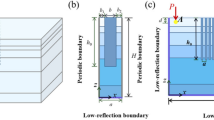Abstract
This paper presents a 2.5D scattering of incident plane SV waves by a canyon in a layered half-space by using the indirect boundary element method (IBEM). A free field response analysis is performed to provide the displacements and stresses on the boundary of the canyon where fictitious uniform moving loads are applied to calculate the Green’s functions for the displacements and stresses. The amplitudes of the loads are determined by the boundary conditions. The free field displacements are added to the fictitious uniform moving loads induced displacements and the total response is obtained. Numerical calculations are performed for a canyon with homogenous and in one layer over bedrock. The effects of the thickness and stiffness of the layer on the amplification are studied and discussed.
Similar content being viewed by others
References
Ba Z (2008), “Green’s Functions for Layered Half Space and Elastic Wave Scattering by Local Sites,” ph.D. Dissertation, Tianjin University, Tianjin. (in Chinese)
Cao H and Lee VW (1990), “Scattering and Diffraction of Plane P Waves by Circular-cylindrical Canyons with Variable Depth-to-width Ratio,” Soil Dynamics and Earthquake Engineering, 9(3): 141–50.
Dravinski M and Mossessian TK (1987), “Scattering of Plane Harmonic P, SV, and Rayleigh Waves by Dipping Layers of Arbitrary Shape,” Bulletin of the Seismological Society of America, 77: 212–235.
Hung HH and Yang YB (2010), “Analysis of Ground Vibrations Due to Underground Trains by 2.5D Finite/Infinite Element Approach,” Earthquake Engineering and Engineering Vibration, 9: 327–335.
Kawase H (1988), “Time-domain Response of a Semicircular Canyon for Incident SV, P, and Rayleigh Waves Calculated by the Discrete Wavenumber Boundary Element Method,” Bulletin of the Seismological Society of America, 78: 1415–1437.
Lee VW and Cao H (1989), “Diffraction of SV Waves by Circular Canyons of Various Depths,” Journal of Engineering Mechanics Division, 115(9): 2035–2056.
Liang J and Ba Z (2007), “Exact Dynamic Stiffness Matrices of 3-D Layered Site and it’s Green’s Functions,” Earthquake Engineering and Engineering Vibration, 27(5): 7–17. (in Chinese)
Liang J, Ba Z and Lee VW (2006), “Diffraction of Plane SV Waves by a Shallow Circular-arc Canyon in a Saturated Poroelastic Half-space,” Soil Dynamics and Earthquake Engineering, 26: 582–610.
Liao Z (2002), Introduction to Wave Motion Theories in Engineering (2nd ed). (in Chinese)
Luco JE, Wong HL and De Barros FCP (1990), “Three Dimensional Response of a Cylindrical Canyon in a Layered Half Space,” Earthquake Engineering and Structural Dynamics, 19: 799–817.
Papageorgiou A and Pei D (1998), “A Discrete Wave Number Boundary Element Method for Study of 3-D Response of 2-D Scatterers,” Earthquake Engineering and Structural Dynamics, 27(6): 619–638.
Pedersen H, Sanchez-Sesma FJ and Campillo M (1994), “Three-dimensional Scattering by Two-dimensional Topographies,” Bulletin of the Seismological Society of America, 84: 1169–1183.
Sainchez-Sesma FJ and Campillo M (1991), “Diffraction of P, SV, and Rayleigh Waves by Topographic Features: a Boundary Integral Formulation,” Bulletin of the Seismological Society of America, 81: 2234–2253.
Stamps AA and Beskos DE (1996), “3D Seismic Response Analysis of Long Lined Tunnels in Halfspace,” Soil Dynamics and Earthquake Engineering, 15: 111–118.
Trifunac MD (1973), “Scattering of Plane SH Waves by a Semi-cylindrical Canyon,” Earthquake Engineering and Structural Dynamics, 1: 267–281.
Vogt RF, Wolf JP and Bachmann H (1988) “Wave Scattering by a Canyon of Arbitrary Shape in a Layered Half Space,” Earthquake Engineering and Structural Dynamics, 16: 803–812.
Wolf JP (1985), Dynamic Soil-structure Interaction, Englewood Cliffs: Prentice-Hall.
Wong HL (1982), “Effect of Surface Topography on the Diffraction of P, SV and Rayleigh Waves,” Bulletin of the Seismological Society of America, 72(4): 1167–1183.
Zhang L and Chopra AK (1991), “Three-dimensional Analysis of Spatially Varying Ground Motions Around a Uniform Canyon in a Homogeneous Half-space,” Earthquake Engineering and Structural Dynamics, 20: 911–926.
Author information
Authors and Affiliations
Corresponding author
Additional information
Supported by: National Natural Science Foundation of China Under Grant No.50908156 and 50978183; Tianjin Natural Science Foundation Under Grant No. 07JCZDJC10100
Rights and permissions
About this article
Cite this article
Zhenning, B., Jianwen, L. 2.5D scattering of incident plane SV waves by a canyon in layered half-space. Earthq. Eng. Eng. Vib. 9, 587–595 (2010). https://doi.org/10.1007/s11803-010-0040-2
Received:
Accepted:
Published:
Issue Date:
DOI: https://doi.org/10.1007/s11803-010-0040-2




